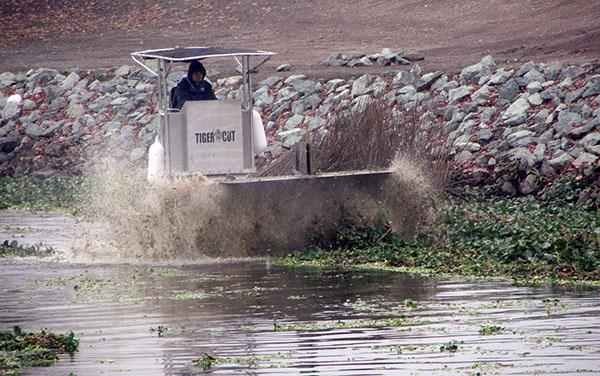Clogged waters threaten boating
Hyacinth danger to boaters, prevents boat parade

Boaters have to be careful when in the water with the hyacinth because it could tangle in the motor and cause the boat to become trapped. So far this plant has not been able to be killed so boaters must stay aware of the waters.
Each vessel in the long line is covered from bow to stern with lights, speakers and people to celebrate the holidays Port City-style: with the Lighted Boat Parade.
This annual tradition usually occurs around the first weekend of December and attracts viewers from all around San Joaquin County, and sometimes beyond. Usually.
This is an unusual year.
Dec. 6 was supposed to be filled with festivity in the downtown area, but it wasn’t because of a pest that shows up in the Deep Water Channel around November each year. The water hyacinth plant, as many can see, covers certain areas of the delta from bank to bank, making the water seem to disappear.
“This is by far the worst year I’ve ever seen,” Roger Kelly, a lifelong resident of Stockton, said. “I’ve been literally trapped by the hyacinth. There’s absolutely no way I can get my boat out of my shed.” He has lived on the water since 1999, cruises his boat throughout the year and plays an active role in the Lighted Boat Parade.
Because of its natural properties, hyacinth poses a dangerous threat to amateur boaters as well as foreign trading ships, who sometimes can’t navigate the waterways at night because the hyacinth is so thick that the radars confuse it with actual land. If a brave ship decided to push through the plant, it may crash into a levee, causing a flood and thousands of dollars in repairs.This plant is also a huge problem for avid boaters in the Delta. “It has really crippled the boating community and the economy,” Kelly said. “I’m just glad that the Department of Boating and Waterways is working to clear the Calaveras, and it sounds like they’re going to hit several more areas that are heavily impacted.”
The Delta is the perfect breeding ground for this highly mobile and tough plant; the vast, nutrient-rich waters serve as a buffet and it’s unlikely that San Joaquin freezes will entirely kill the plant. Even if a miracle happened and it did, the seeds, which sink to the bottom, last for 20 years so the hyacinth will be back when spring comes again.
“It thrives on water that has a lot of nutrients in it,” Alex Breitler, a Record staff writer who focuses on environmental issues, said. “It’s an issue in the Delta because you have fertilizer from farms going into the water so it makes it reproduce really fast.”
Although it may not look like it, California has been working since March to control the hyacinth. Workers have been spraying herbicides until the end of November, which is when the state’s permit ended. But the state, along with the Port of Stockton, continued to work by hiring private contractors with special boats to cut through the plant and take the hyacinth out of the water.
“The state has spent several million dollars a year spraying herbicides up and down the central valley,” Breitler said. “This is supposed to reduce the invasion, but in the past few years it hasn’t worked too well.”
The hyacinth plant won’t be destroyed, but it can be controlled with the proper precaution. Several years ago, the state forgot to renew its permit to spray the plant, which led to a dramatic increase in hyacinth throughout California.
If the state stays on top of this issue, by renewing permits, spraying year-round and taking the plant out of the water, then future infiltrations won’t be as bad as this year.
There is one more step to be taken in order to prevent this occurrence. “Boaters must be aware,” Kelly said. “If they see the hyacinth in early months, then they should report it and where it is. This definitely has to be a learning experience.”





